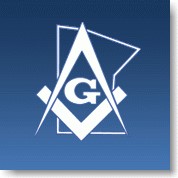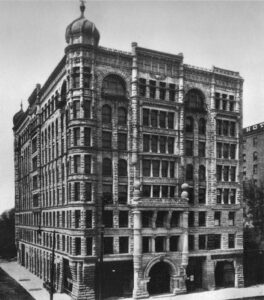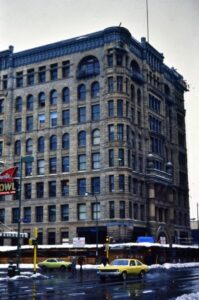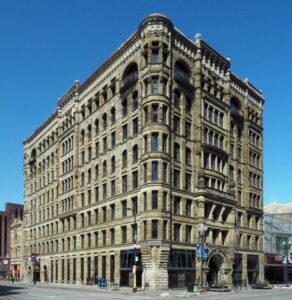The Masonic Temple
1890, 1947, 1978
PDF of the Masonic Temple History
The Masonic Temple, now known as the Hennepin Center for the Arts, was completed in 1890, at the corner of Hennepin Avenue and Sixth Street North. Considered a prime example of Richardsonian Romanesque architecture, it was originally home to the Freemasons as a Masonic Lodge and has more recently been utilized as a center for the arts in the city.
Freemasonry existed in Minnesota before statehood was established, with the first Masonic meeting recorded in 1849, in St. Paul. The Minnesota Grand Lodge was established in 1853, serving as a sort of headquarters that oversaw the more localized lodges in each city. Today there are over 150 local Masonic Lodges in Minnesota, with over 20,000 members statewide.
 By the 1880s, the Freemasons in Minneapolis wanted to construct a building large enough to accommodate its members. The organization settled on a site on Hennepin and Sixth Avenue North, and after raising capital stock, began construction in 1888, on an eight-story building. The building was designed by Minneapolis architects, Long and Kees (Minneapolis City Hall and the Lumber Exchange are among their other credentials). The building was designed in the Richardsonian Romanesque architectural style using Ohio light sandstone for the exterior.
By the 1880s, the Freemasons in Minneapolis wanted to construct a building large enough to accommodate its members. The organization settled on a site on Hennepin and Sixth Avenue North, and after raising capital stock, began construction in 1888, on an eight-story building. The building was designed by Minneapolis architects, Long and Kees (Minneapolis City Hall and the Lumber Exchange are among their other credentials). The building was designed in the Richardsonian Romanesque architectural style using Ohio light sandstone for the exterior.
 The exterior was intricately detailed with Masonic symbols, including celestial and terrestrial carvings. Additionally, two onion domes (since removed due to their deteriorating condition) were placed at the top of the building, symbolizing the exotic character of the Masonic order. The building boasts four Syrian-arched balconies. In the fourth story, a balcony bears the carved letters “MASONIC TEMPLE.” The eighth story has Egyptian-winged sun motifs above the windows. The interior included over one hundred offices for the Masonic order, as well as a general store on the ground floor. The eighth floor of the building was devoted entirely to a large banquet and event hall for the Masons.
The exterior was intricately detailed with Masonic symbols, including celestial and terrestrial carvings. Additionally, two onion domes (since removed due to their deteriorating condition) were placed at the top of the building, symbolizing the exotic character of the Masonic order. The building boasts four Syrian-arched balconies. In the fourth story, a balcony bears the carved letters “MASONIC TEMPLE.” The eighth story has Egyptian-winged sun motifs above the windows. The interior included over one hundred offices for the Masonic order, as well as a general store on the ground floor. The eighth floor of the building was devoted entirely to a large banquet and event hall for the Masons.
The building was owned by the Masons until 1947, at which point it was sold for $175,000 to Lincoln McWhinney, was turned into a merchandise center, and was renamed the Merchandise Building. Above the door, gilt letters were added “528 MERCHANDISE BUILDING.” Some Masonic lodges remained in the building after the sale. A Minneapolis Star article from July 1, 1947, detailing the sale, described the building as a “landmark” in downtown Minneapolis.

In 1975, the building was listed on the National Register of Historic Places, a significant boost at a time when the building was in poor shape, and rumblings of tearing it down had been heard. In need of a revamp, the Hennepin Center for the Arts purchased the building for $500,000 in 1978 and completed a renovation (costing several million dollars) to turn it into an arts center that would provide space to non-profit arts organizations for performing, teaching, studio, and office facilities. The renovations to the building included a new roof, new windows, and a chemical wash to the exterior that removed grime from the Ohio light sandstone exterior.
The building has remained a center for the arts since 1978, and it is now a part of the Cowles Center for Dance and the Performing Arts. The Cowles Center is a combination of the Masonic Temple building, a newly built atrium (2011), and the Shubert Theatre (relocated next door in 1999). The eighth-floor former Masonic event center is now home to a beautiful theatre, and several other performance spaces are scattered throughout the building.
